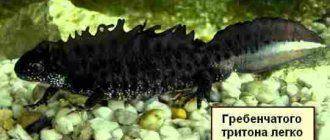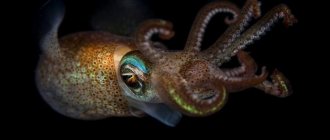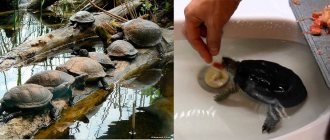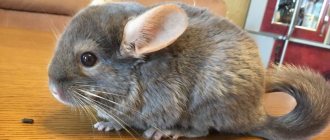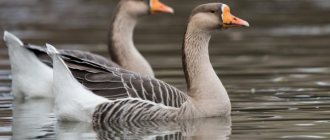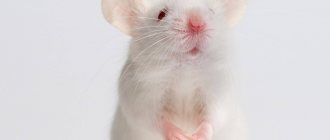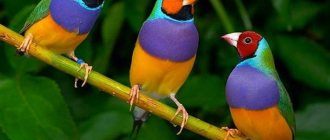Appearance of the Java leaf moth
The body length of an adult female Java leaf moth is 7 centimeters, while males do not exceed 5 centimeters in length.
A distinctive feature of the Javan leaf beetle, in comparison with other representatives of the genus, are 2 small spots on the abdomen of a brown color with red specks. Due to the wide elytra, these insects look like leaves.
Java leaf beetle (Phyllium bioculatum).
The camouflage of the Javan leaf beetle is simply amazing; in the greenery it is practically unnoticeable. This camouflage is explained by the fact that these insects are completely defenseless against predators: they are sedentary, non-aggressive and non-poisonous.
Adult females have wings, but they do not use wings. Males have a less wide abdomen and longer wings that cover the abdomen. The antennae of males are also several times longer than those of females.
Giant Leafweed
Phyllium giganteum
Type – arthropods
Class - insects
Squad - Ghosts
Family - leaf beetles
Genus – phyllium
Appearance
The body length is 80-120 cm. The main color background varies from greenish to yellowish or slightly brownish. The body shape resembles an oak leaf. There are red-brown spots along the edges. Male individuals have wings and can fly. They are darker in color than females and have longer antennae.
Habitat
The giant leaf beetle lives naturally in Malaysia.
Nutrition
The diet is based on banana (Musaceae), mango (Mangifera) and guava (Psidium) leaves. To a lesser extent, the foliage of plants from the Rosaceae family is eaten. Older leaves are preferred.
Before the first molt, nymphs, unlike their older brothers, specialize in young leaves, eating away at the edges of their most tender parts.
Behavior
During daylight hours, the leafhopper remains motionless in its place. It is almost impossible to notice it among the foliage. Getting this master of mimicry to move during the day is also very difficult. It becomes active only as dusk approaches.
When caught, adult individuals make a peculiar noise using the stridulation apparatus. It resembles the buzzing of a bee and scares off many predators.
Reproduction
Reproduction is carried out mainly without the participation of males - using parthenogenesis.
Only females are born, which are sometimes called maternal clones.
Parthenogenesis helps maintain population numbers within limits, significantly reducing the risk of unwanted genetic changes. If an accidental male manages to fertilize a female, then among his offspring there will also be males.
Some males are unable to reproduce. Most of them live only a few days, only a few live up to one week.
After the last molt, the female lays daily up to 5 porous oblong eggs measuring 8x4 mm and weighing about 34 mg in 3-4 weeks. They are colored brownish, gray or blackish.
Red-brown nymphs, about 20 mm long, hatch 8-12 months after laying. After the first molt, they acquire a greenish tint, which gradually intensifies in subsequent stages of development. It lasts on average about a year.
Captive
The lifespan of female giant leaf moths can reach 10 months.
For the comfortable well-being of representatives of this species, it is necessary to create an appropriate microclimate in the insectarium. It is advisable to constantly maintain the temperature in the range from 22°C to 26°C, and humidity - about 80%. At the same time, a supply of fresh air should be provided.
To improve ventilation, you can use an aquarium with wooden slats glued to it and covered with gauze, or you can place a low-power fan nearby for a couple of hours. A light breeze in the evening encourages insects to go feeding.
For adult individuals, an insectarium with a volume of 40x40x50 cm is sufficient. Branches are placed in it, on which the pets will rest during the day. Peat or moss is used as soil. They will help maintain the desired level of humidity.
To prevent mold, it is recommended to add springtails (Collembola) to the stick insects. These creatures will take on the role of sanitation workers, eating uneaten plant debris, mold and feces.
The leaf beetles are fed oak (Quercus), raspberry (Rubus idaeus), rose hip (Rosa) and bushy blackberry (Rubus fruticosus) leaves.
Keeping Javanese leafhoppers at home
These insects are kept in ordinary vertical insectariums, which must have good ventilation.
Leaf moths spend their entire lives on the leaves of trees and bushes, which they imitate with their shape and body color, and on which they feed.
Javanese leafhoppers are kept at a temperature of 24-26 degrees, and for a comfortable life they need lighting for 8-10 hours, preferably with natural light.
REPRODUCTION
An adult female, some time after the last molt in her life, is already capable of mating. In some species of stick insects, males are much less common than females. Therefore, females can lay unfertilized eggs, from which offspring hatch. This phenomenon is called parthenogenesis. Asexual reproduction, which most females are capable of, has a very important drawback: the cubs that appear as a result of parthenogenesis are exact copies of their mothers. In order for the further development of the species to be possible, the participation of male insects is necessary so that at least part of the eggs are fertilized. It is not difficult for stick insects that live in flocks to find a partner; it is more difficult for individuals of species that are characterized by solitary existence. Females of these species secrete pheromones to attract males. The male fertilizes the female by transferring a spermatophore to her. After 2 weeks, the female lays large, seed-like eggs (usually up to 300). The young individual, which emerges from the egg after completion of metamorphosis, strives to quickly get to food.
Feeding leafhoppers
Java leaf beetles are fed with raspberry, oak and blackberry leaves; they can also be given strawberry, guava, and privet leaves.
It should be borne in mind that young leaf beetles prefer tender parts of plants, but they should not be given leaves that have just opened from the buds, since they contain substances that are poisonous to insects.
Keeping leaf insects at home will require special attention to the food that these insects feed on.
You can’t feed the leafhoppers with dried leaves, so you’ll have to solve the issue of winter food: you’ll need to plant indoor strawberry bushes and germinate oak trees from acorns. It must be taken into account that with a sudden change of food, the insect may die, so the leaf beetles are gradually accustomed to the new food.
Listotele
Well, there are a lot of unusual living creatures in the tropics! Well, the climate here is warm and humid, there are more than enough plants, so those who eat greens are bred. And behind them come those who don’t mind running for their own lunch. Birds, insects, fish and animals - they are all busy with something. For example, they catch up with their breakfast, not suspecting that they themselves will soon become someone’s dinner.
flickr/Rashad Ujaimi
Although no, they suspect. Otherwise, why would they come up with so many ways to outwit predators? However, the leaf beetle surpassed them all! This large insect from the order ghostly is so reminiscent of an inconspicuous, withered leaf that it is practically no different from it. You take such a leaf in your hands, but - raaaaz - and it runs away. It doesn’t take long for you to start stuttering...
flickr/Serge THELLIER
Leaf-bodies or leaf-bearing insects (lat. Phylliidae) are a whole family of insects that are common in the tropical zone of Southeast Asia, on the islands of Melanesia and in northeastern Australia.
flickr/Houston Museum of Natural Science
Their maximum size is 12.5 cm. The body is wide and flattened in females, elongated and long in males. The legs imitate small leaves: they are slightly expanded, leaf-shaped. Females have no back pair of wings, so they cannot fly. They move slowly, freezing for a long time on branches or on leaf petioles.
flickr/Paul in Uijeongbu
But males fly beautifully, they are very mobile and are even capable of autonomy (throwing away part of the body when in danger). They are not so leaf-like: their elytra are shortened and dense. The body color of leafhoppers not only harmonizes with the surrounding foliage, it literally merges with it. Females even have small and thin veins on their elytra that imitate the veining of plants.
flickr/0rganlc
Today there are 4 genera in the leaf beetle family, which include 51 species. However, the most interesting thing is that over the 47 million years of their existence on our planet, they have practically not changed. Apparently, such a disguise is already ideal, so why change anything?
flickr/bug eye
Scientists searching for fossil remains discovered this quite recently. Although it is quite possible that they had come across such insects before, and they mistook them for ordinary leaves. Safely hidden, cunning ones.
flickr/crazysw
Leaf beetles reproduce by laying eggs. Their larvae do not look like leaves at all, but they have a reliable, protective coloring that allows them to hide from enemies.
flickr/Celimaniac
These insects feed on plants, gnawing them using their forward-directed, gnawing mouthparts. Their activity is directly opposite to that of their enemies. For example, in hot climates, where the afternoon heat forces all inhabitants of the tropics to lie down in the shade, leaf beetles are active during the day, and stand motionless in the morning, evening and night. If in their habitat predators look for victims during the day, then leaf beetles are active at night.
flickr/supreme & Co
Very often, leafhoppers hang under a branch or under the petiole of a leaf, clinging to it with only two legs. At the same time, they slowly turn their body from side to side, depicting a leaf hanging on a thin thread, which sways with a light breeze. “I’m a leaf, a leaf, a leaf, I’m not lunch at all...”
External description of the leaf butterfly
When the leaf butterfly's wings are folded, it is practically indistinguishable in appearance from a dry leaf.
It was thanks to this similarity that the common name of the genus appeared - leafweed. It is leaf butterflies (callimas) that are perhaps the most illustrative example of mimicry in nature.
The leaf butterfly is so similar to a dried leaf that even a specialist who is well acquainted with this insect, stroking the branch where this insect sits and, knowing that it is sitting there, cannot immediately distinguish it. The shape, color, shades and veins of the wings of the Kalima completely, in the smallest detail, imitate a dry leaf.
Leaf butterfly (Kallima inachus).
Surprisingly, even the edges of the wings of the leaf butterfly look torn and frayed, like a dry leaf. However, the similarity with a dry leaf does not end there: in order to achieve maximum resemblance to a dried leaf, the kalima folds its wings in such a way that the hind wings, with their short outgrowths, rest against the branch, as if it were a petiole.
As for the inner surface of the wings of these camouflage geniuses, it has a rich blue color or a bright metallic blue. Leaf butterflies fly quite quickly and, thanks to such a specific coloring, during flight they become very beautiful and noticeable.
The beauty of the leaf butterfly is complemented by a wide yellow or orange stripe located on the front wings. Some butterflies also have black tops with white spots clearly visible against a black background.
On top, the wings of the leaf butterfly are brightly colored, but on the inside they look like a dried leaf.
The longest insect in the world / The largest insect in the world. Video (00:01:34)
At the moment, the largest insect is the stick insect Phobaeticus chani (Chan's Megastick, Phobeticus Chani) from the insect family Phasmatidae. The length of this insect reaches more than 50 cm in length. Entomologists discovered this giant in the jungle of the Malaysian state of Sabah.
In total, only three specimens of these insects were found, so this species can claim to be the rarest species among insects. The stick insects were named after the outstanding entomologist Datuk Chan Zhaolun (Chhan Chhiulen), who first discovered and began to study this species.
The most outstanding individual reached a length of 56.7 cm, of which the body length was 35.7 cm. This specimen was discovered in 1989 in the forests of the island of Kalimantan. It was only in 2008 that this individual was transferred to the staff of the London Natural History Museum, after which it was described by Philip Bragg as a new species.
Although two years have passed since the discovery, unfortunately, the lifestyle of insects has not been studied at all.
TYPES OF STICKS
Australian stick insect:
Lives in Australia.
Protection:
The Australian stick insect raises the back of its abdomen and tries to imitate the attacking scorpion.
Musk stick insect:
lives in Madagascar. The open wings of this casing shimmer with all the colors of the rainbow.
Indian stick insect:
inhabits the entire Indian subcontinent. The green color provides it with excellent camouflage among the foliage.
WHERE DOES IT LIVE?
They are numerous throughout the tropical and subtropical zones, as well as in warm temperate regions.
PROTECTION AND PRESERVATION
Most stick insects live in virtually unexplored areas, so their numbers are unknown. They feed on certain types of plants, so they are in danger of extinction as a result of tropical deforestation.
Stick insect nutrition
Stick insects are exclusively vegetarians, eating only plant foods. Their diet consists of leaves of a variety of plants: woody, shrubby and herbaceous. Several species cause significant damage to agriculture by eating planted crops.
In captivity, domestic stick insects prefer fresh branches of fruit trees such as raspberries, blackberries, and rose hips. They won’t refuse strawberry or oak leaves either. Their diet should always include fresh greens, so breeders prepare food for stick insects for the winter.
In the photo there is a goliath stick insect
They freeze branches and leaves or sprout acorns at home. The unusual beetles also liked the houseplants: hibiscus and tradescantia. Therefore, there are fewer problems keeping stick insects But everyone is advised not to change food for stick insects if they are accustomed to one variety. This can even lead to the death of the insect.
Features and habitat of the stick insect
The stick insect is an amazing insect ; it belongs to the order of ghosts. There are more than 2500 species of them. Outwardly, it resembles a stick or leaf. You can verify this by looking at the photo of the stick insect .
He also has a head with antennae; body covered with chitin; and long legs. The stick insect is recognized as the longest insect. A record holder lives on the island of Kalimantan: its length is 56 cm.
On average, these insects are from 2 to 35 cm. Their color is brown or green. It can change under the influence of heat or light, but rather slowly. Special cells containing pigments are responsible for this.
On the small round head there are eyes; by the way, stick insects have excellent vision, and a gnawing type mouthparts capable of overpowering branches and hard veins of leaves.
The body is narrow or with a flattened abdomen. The legs are covered with thorns or spines and look like stilt sticks. They end with suction cups and hooks that secrete a sticky liquid.
The stick insect can move quickly using this, even along a glass wall. Some species have wings, which they can use to fly or glide.
These amazing stick insects live in the tropics and subtropics near fresh water bodies. Most of all they love thickets of succulent bushes. Although there are exceptions, the Ussuri stick insect can also be found in the Russian Far East, the Caucasus and the mountains of Central Asia.
Natural enemies of the leaf butterfly
The leaf butterfly has more than enough enemies in its natural habitat. These include wasps, spiders, ants, birds and even some bacteria. True, the behavior of leaf butterflies puzzles birds. Having noticed a leaf-winged butterfly and choosing it as prey, the bird is ready to grab a fluttering or sitting insect, but at the same moment it disappears and in its place only a dried leaf remains, which is of no interest.
Leaf butterflies are a prime example of mimicry.
